All-inclusive Northern Lights trips in Tromsø, Norway. Small groups, big experiences! Highly qualified guides ensure unique and unforgettable adventures with a personal touch. Visit Explore the Arctic | | |
MARS VISIBLE IN BROAD DAYLIGHT: Astronomers have long known that the brightest planets can be seen with the naked eye in daylight. Usually this means Venus and Jupiter. Now Mars has joined the club. On July 6th in Trieste, Italy, Giorgio Rizzarelli saw the Red Planet with his unaided eye--a pinprick of dusty orange piercing the morning blue even after sunrise. He took these pictures, which simulate the view without optics. Browse: Mars Photo Gallery.
WHITE SUNSPOT: This weekend, observers of the sun have been waiting for something to emerge over the sun's eastern limb. We knew it was there because of a farside solar flare on July 6th. Today it arrived, and it appears to be a white sunspot:
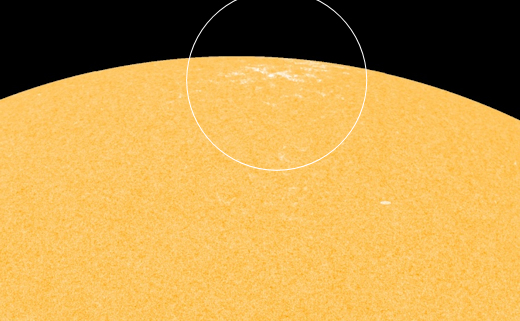
The correct name of this phenomenon is "faculae." It is a cousin of sunspots.
Regular dark sunspots are magnetic islands on the surface of the sun. Magnetic fields in these areas are thousands of times stronger than Earth's magnetic field. Sunspot magnetic fields are so strong, they block the flow of heat from the nuclear furnace below. They appear dark because they are relatively cool compared to their surroundings.
Faculae are also made of magnetic fields. However, the magnetism of faculae is concentrated in much smaller bundles than in sunspots. Instead of blocking heat from below, they essentially form corridors that allow us to see into sun's hot interior, creating an apparent bright spot on the surface of the sun.
It is still possible that a dark core will follow these faculae over the limb in the hours ahead, establishing the region as a normal sunspot group. Stay tuned. Free: Solar Flare Alerts
Realtime Space Weather Photo Gallery
ONE RING ABOVE HOBBITON: Two weeks ago, the students of Earth to Sky Calculus traveled to New Zealand for an unprecedented launch of space weather balloons over Earth's 8th continent. To help fund their trip, they sent this ring of power to the stratosphere:
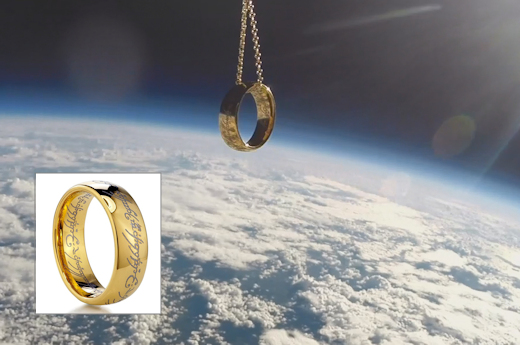
You can have it for $129.95. On the southern winter solstice, June 21st, the ring flew 109,580 feet above New Zealand's north island, passing almost directly above Hobbiton, the movie set for the Lord of the Rings. The band is made of golden-colored tungsten and inscribed with the authentic Mordor script of the One Ring. Along with the ring, you'll receive a greeting card showing the item in flight and telling the story of its journey to the edge of space.
Far Out Gifts: Earth to Sky Store
All proceeds support hands-on STEM education
WHY ARE NOCTILUCENT CLOUDS BLUE? Observers of noctilucent clouds (NLCs) often describe their color as "electric blue." This high-voltage photo taken July 7th by Pentti Arpalahti of Helsinki, Finland, is a great example:
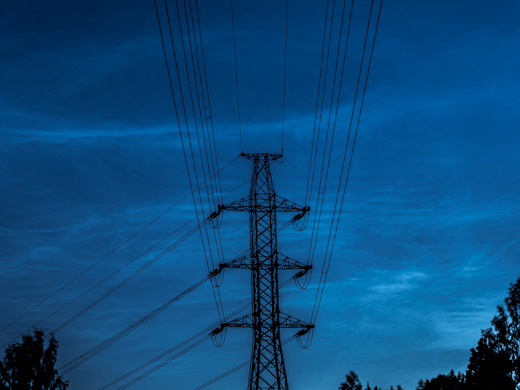
But why? What makes these clouds of frosted meteor smoke the color of an electric discharge? It turns out, electricity has nothing to do with it.
NLCs are blue for two reasons: (1) The clouds consist of tiny ice crystals about the size of particles in cigarette smoke. Cigarette smoke looks blue, too, and for the same reason. Tiny particles scatter blue light better than other colors. (2) Ozone! Research in the 1970s revealed that some of the sunlight hitting noctilucent clouds first passes through Earth's ozone layer. Ozone tends to scatter red light, while allowing blue to pass. Sunbeams hitting noctilucent clouds have thus been pre-conditioned for blue.
Realtime Noctilucent Cloud Photo Gallery
Realtime Aurora Photo Gallery
Every night, a network of
NASA all-sky cameras scans the skies above the United States for meteoritic fireballs. Automated software maintained by NASA's Meteoroid Environment Office calculates their orbits, velocity, penetration depth in Earth's atmosphere and many other characteristics. Daily results are presented here on Spaceweather.com.
On Jul. 8, 2018, the network reported 16 fireballs.
(15 sporadics, 1 July Pegasid)
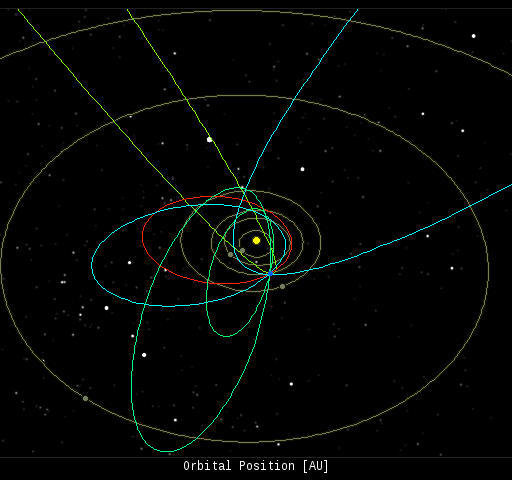
In this diagram of the inner solar system, all of the fireball orbits intersect at a single point--Earth. The orbits are color-coded by velocity, from slow (red) to fast (blue). [Larger image] [movies]
Potentially Hazardous Asteroids (
PHAs) are space rocks larger than approximately 100m that can come closer to Earth than 0.05 AU. None of the known PHAs is on a collision course with our planet, although astronomers are finding
new ones all the time.
On July 8, 2018 there were 1912 potentially hazardous asteroids.
 |
Recent & Upcoming Earth-asteroid encounters: | Asteroid | Date(UT) | Miss Distance | Velocity (km/s) | Diameter (m) |
| 2018 NQ | 2018-Jul-03 | 10.4 LD | 24.5 | 132 |
| 2018 MB7 | 2018-Jul-04 | 2.8 LD | 11.6 | 62 |
| 2018 NJ | 2018-Jul-07 | 2.4 LD | 6 | 10 |
| 2018 NM | 2018-Jul-17 | 1.4 LD | 6.7 | 19 |
| 2018 LQ2 | 2018-Aug-27 | 9.4 LD | 1.5 | 41 |
| 2016 GK135 | 2018-Aug-28 | 16.8 LD | 2.8 | 9 |
| 2016 NF23 | 2018-Aug-29 | 13.3 LD | 9 | 93 |
| 1998 SD9 | 2018-Aug-29 | 4.2 LD | 10.7 | 51 |
| 2018 DE1 | 2018-Aug-30 | 15.2 LD | 6.5 | 28 |
| 2001 RQ17 | 2018-Sep-02 | 19.3 LD | 8.3 | 118 |
| 2015 FP118 | 2018-Sep-03 | 12.3 LD | 9.8 | 490 |
Notes: LD means "Lunar Distance." 1 LD = 384,401 km, the distance between Earth and the Moon. 1 LD also equals 0.00256 AU. MAG is the visual magnitude of the asteroid on the date of closest approach. | | Cosmic Rays in the Atmosphere |
Readers, thank you for your patience while we continue to develop this new section of Spaceweather.com. We've been working to streamline our data reduction, allowing us to post results from balloon flights much more rapidly, and we have developed a new data product, shown here:
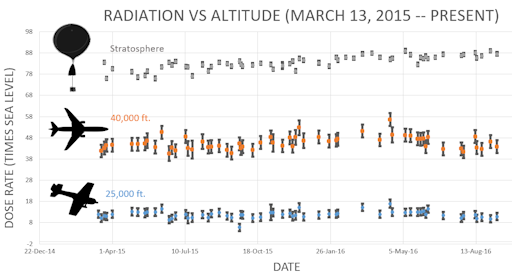
This plot displays radiation measurements not only in the stratosphere, but also at aviation altitudes. Dose rates are expessed as multiples of sea level. For instance, we see that boarding a plane that flies at 25,000 feet exposes passengers to dose rates ~10x higher than sea level. At 40,000 feet, the multiplier is closer to 50x. These measurements are made by our usual cosmic ray payload as it passes through aviation altitudes en route to the stratosphere over California.
What is this all about? Approximately once a week, Spaceweather.com and the students of Earth to Sky Calculus fly space weather balloons to the stratosphere over California. These balloons are equipped with radiation sensors that detect cosmic rays, a surprisingly "down to Earth" form of space weather. Cosmic rays can seed clouds, trigger lightning, and penetrate commercial airplanes. Furthermore, there are studies ( #1, #2, #3, #4) linking cosmic rays with cardiac arrhythmias and sudden cardiac death in the general population. Our latest measurements show that cosmic rays are intensifying, with an increase of more than 13% since 2015:
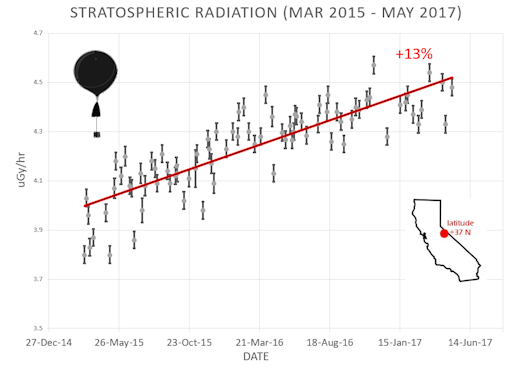
Why are cosmic rays intensifying? The main reason is the sun. Solar storm clouds such as coronal mass ejections (CMEs) sweep aside cosmic rays when they pass by Earth. During Solar Maximum, CMEs are abundant and cosmic rays are held at bay. Now, however, the solar cycle is swinging toward Solar Minimum, allowing cosmic rays to return. Another reason could be the weakening of Earth's magnetic field, which helps protect us from deep-space radiation.
The radiation sensors onboard our helium balloons detect X-rays and gamma-rays in the energy range 10 keV to 20 MeV. These energies span the range of medical X-ray machines and airport security scanners.
The data points in the graph above correspond to the peak of the Reneger-Pfotzer maximum, which lies about 67,000 feet above central California. When cosmic rays crash into Earth's atmosphere, they produce a spray of secondary particles that is most intense at the entrance to the stratosphere. Physicists Eric Reneger and Georg Pfotzer discovered the maximum using balloons in the 1930s and it is what we are measuring today.
| | The official U.S. government space weather bureau |
| | The first place to look for information about sundogs, pillars, rainbows and related phenomena. |
| | Researchers call it a "Hubble for the sun." SDO is the most advanced solar observatory ever. |
| | 3D views of the sun from NASA's Solar and Terrestrial Relations Observatory |
| | Realtime and archival images of the Sun from SOHO. |
| | from the NOAA Space Environment Center |
| | fun to read, but should be taken with a grain of salt! Forecasts looking ahead more than a few days are often wrong. |
| | from the NOAA Space Environment Center |
| | the underlying science of space weather |
 | Reviews here can help you to pick up best memory foam mattresses. |
| | These links help Spaceweather.com stay online. Thank you to our supporters! |
| | | | | | |

